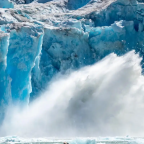
Predictions of the death of the Great Barrier Reef are wide of the mark, according to one of the most prominent researchers in the field. Marine biologist David Bourne from James Cook University says global warming and other pressures will not end up destroying the reef – but will instead bring about major changes in biodiversity.
“There is always going to be winners and losers,” he says. “The reef is still going to be there, it just may be a very different reef to what we have today.”
And perhaps the key element in determining which species of coral thrive and which suffer in the reef’s future might be bacteria.
Bourne says the volcanic seeps in Papua New Guinea dramatically affect the diversity of coral reef species. The seeps release carbon dioxide from the sea floor, and increase the surrounding water’s acidity levels. He believes the reason why particular coral species tolerate the extreme conditions over others is the bacteria living inside their tissues.
“Trying to link in how they function and whether they’re actually helping the coral survive is the next step. They’re obviously taking advantage of the high CO2 levels, and that may be a continual nutrient supply into the corals.”
Earlier this year, he and colleagues published a review of the potential of microbes to act as early warning indicators for reef health. The study was published in the journal Marine Biology.
Bourne predicts microbes might be the next best chance for coral survival as ocean acidification gradually increases. “There’ll be adaption and acclimation from the coral host itself, and all these microbial partners will probably play a role in helping that acclimation or adaption of the coral,” he explains.
The composition of coral species in the Great Barrier Reef has already changed, following the recent bleaching events and subsequent mortalities.
“It will be interesting to see what recovery occurs over the next few years and if there are more impacts associated with bleaching or cyclones,” says Bourne.
When corals are exposed to prolonged bouts of hot weather they stress and produce large quantities of mucus. This mucus contains vitamin C, and its antioxidant qualities benefits coral recovery. However, it is also a food source for pathogenic bacteria, exposing corals to the risk of infection.
To combat threats from disease, the microbial species in coral mucus and tissues produce antibiotics like an immune system.
“They’re very fast and very quick at finding niches and exploiting the system around them,” explains Bourne, “so having shifts or changes in that microbial community that can actually increase the resilience of corals will be important.
“Ultimately, the best way to prevent any disease is to reduce what’s causing that outbreak. That association with environmental stress is the main avenue you have in terms of best management practice to increase resistance in the coral.”
He adds that in future, bacteria might be used as vectors to infect corals and their algal symbionts with genes more tolerant to warmer oceans and bad water quality.
“Trying to manipulate these communities is definitely an option to increase resilience or their capacity to be buffered against climate change,” he says.
Reef remediation measures being investigated include 3D printing of corals.
“The issue with climate change, and associated bleaching events and even acidification, is you’re losing the structure of the reefs,” he says. “The idea of 3D printing is to actually maintain that structural complexity and that will help all the small organisms that require hiding holes to avoid predation.”
“Obviously, it will have to go hand in hand with other restoration activities in terms of enhancing coral growth that drives a lot of the primary production. It’s definitely an interesting area and needs a lot more work and investment to see how we can tie in all these ideas to actually preserve reefs going into the future.”












Social Profiles